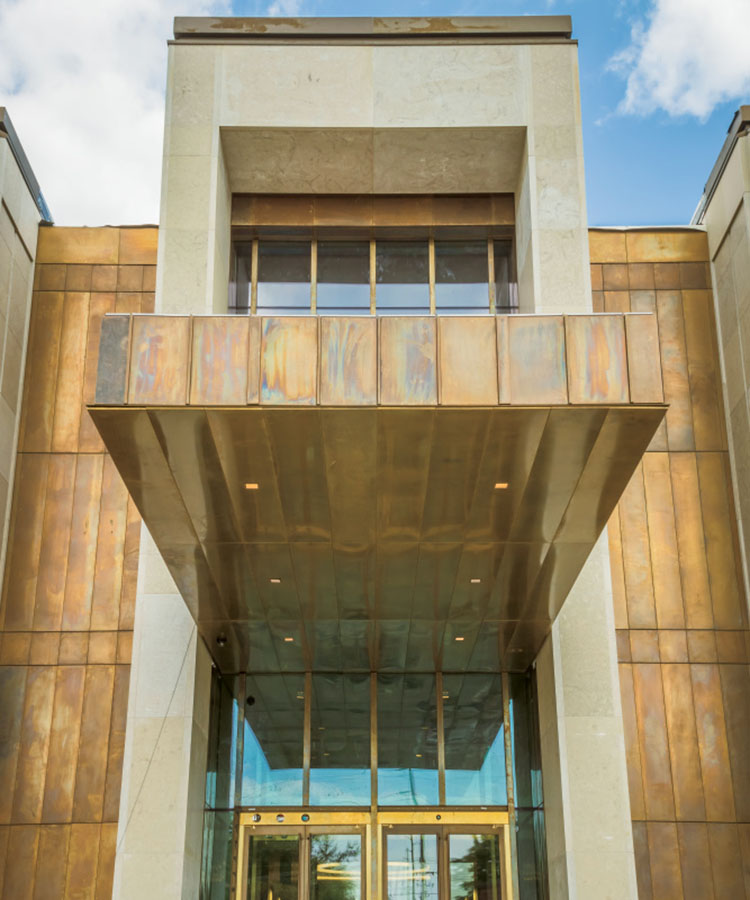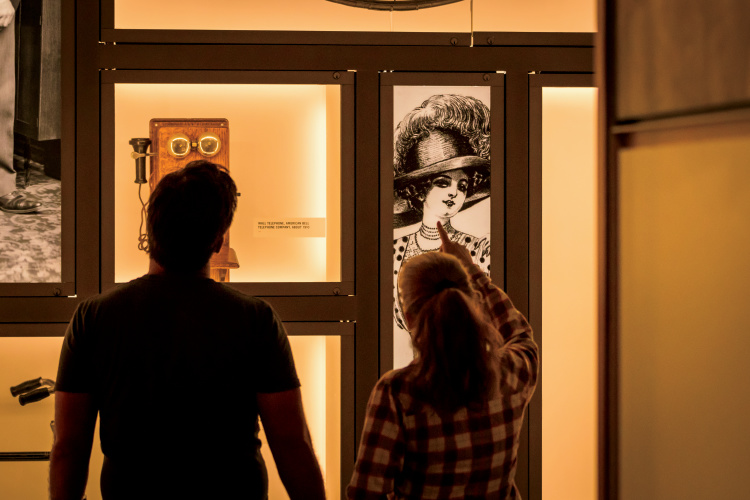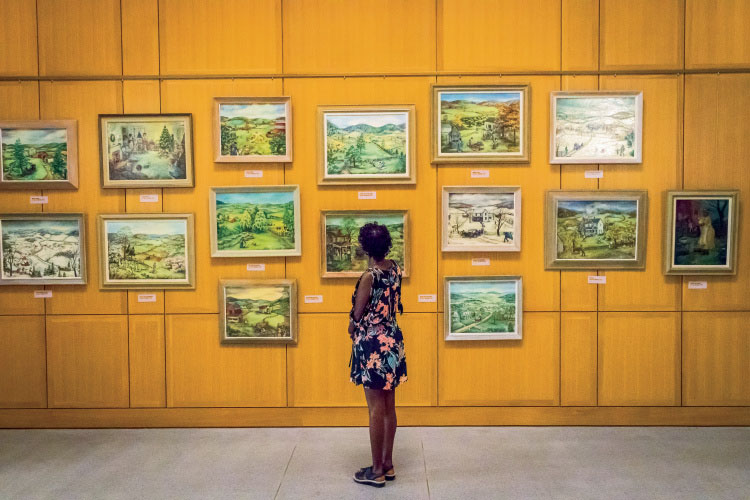4 Ways to Experience History at the Tennessee State Museum
As you walk toward the entrance of the brand-new Tennessee State Museum, bits of state history jump out before even stepping inside the building – during the right season, you’ll even find pretty purple irises, the state flower, lining the walkway.
Located just outside downtown Nashville, the independent museum opened in October 2018 after being housed in the Tennessee Performing Arts Center for more than 35 years. The impressive building harbors an extensive collection of artifacts and information, painting the picture of Tennessee from its very first peoples to present day.

Photo by David Duplessis
Enter the Tennessee Time Tunnel
Visitors start in the Tennessee Time Tunnel, from where they can enter each of the museum’s permanent exhibits: Natural History, First Peoples, Forging a Nation, the Civil War and Reconstruction, Change and Challenge, and Tennessee Transforms.
See more: 9 Tennessee History Facts From the Tennessee State Museum
“One of the things that’s really different in the new space is documentary films in every single exhibition,” says Joe Pagetta, director of communications. “All of them have a five- to 10-minute film as soon as you walk into the gallery. It’s really great to see dozens of people sitting around watching the films.”
For example, in the Natural History exhibit, the film and other markers depict Tennessee’s changing landscape, beginning with its geological creation. Visitors learn facts and tidbits, including that research suggests that the Appalachian Mountains eroded completely and then rose again several times. The last uplift occurred about five million years ago, and in 2000, road workers discovered fossils that had been preserved in a sinkhole in Gray, Tennessee, which served as a rare record of state life from that time.

Photo by David Duplessis
The transition into First Peoples showcases the state’s native tribes, who first inhabited the land. The town of Eva, Tennessee, in Benton County remains one of the best-documented archaic sites in the state. According to findings from archaeologists, native peoples called Eva home between 6000 and 4000 BCE. Fossils and other excavations showed that the earliest people most likely hunted deer, while later inhabitants dined on fish and river mussels, which created a mound-like deposit of mussel shells. Fossils, arrowheads and some of the earliest weapons can be seen in this gallery.
See more: History Lesson at the Tennessee River Museum
Get to Know Tennessee’s Presidents
In Forging a Nation, the museum dives headfirst into the creation of Tennessee as the 16th state as well as early, polarizing politicians, including Andrew Jackson and James K. Polk. Pagetta says that the museum wanted to make sure to cover all of the state’s history, whether perceived as good or bad.
“It’s important for people to know the state’s role and what it did. In Forging a Nation, there’s an entire section focused on slavery, and the images have names to connect them with humanity,” Pagetta says. “Right when you get past Jackson, there’s an entire section on the Trail of Tears. I think people are surprised to see that part of history so well represented in the museum.”

Photo by David Duplessis
Both Polk and Jackson helped to build the country as some of the nation’s earliest presidents. Polk added more than 500,000 square miles to the United States during his single term in office – thanks to a campaign promise, he did not seek re-election for a second term.
Andrew Jackson was one of the state’s largest slaveholders at his time of death in 1845, and his legacy was complicated thanks to his urging of the Indian Removal Act, also known as the Trail of Tears, as well as his termination of the national bank. Jackson’s 1828 election, against John Quincy Adams, was also the first that is reminiscent of today’s elections, with supporters on both sides holding rallies and planning smear campaigns.
See more: What to See at the New Scopes Trial Museum

Photo by David Duplessis
Explore the Civil War & Civil Rights
In the Civil War and Reconstruction exhibit, visitors can experience several of the museum’s many impressive interactive displays.
“There’s a table with a digital screen that shows how the Civil War affected every county in the state,” Pagetta says. People can click on each county and see the role its people played in the war. “Our point with that was to drill down and tell the stories of Tennesseans that maybe haven’t been the focus of history museums in the past.”
Following the Civil War, the Change and Challenge exhibit shows how Tennesseans dealt with social changes and international conflict, including WWI, WWII and the Great Depression.
During this time, from 1870 to 1956, both civil rights and women’s rights were major issues in the state.

Photo by David Duplessis
“Tennessee had a significant role in women’s suffrage in the fact that we were the 36th state to vote yes to the 19th amendment,” Pagetta says. “There were 36 states needed to ratify the amendment, and by the time it got to Tennessee, there were eight states that had already voted against it. We were the last great hope and deciding vote.”
Finally, Tennessee Transforms covers history from 1945 through the present, focusing heavily on the civil rights movement, advancements in technology and important cultural changes including music and sports.
After the ruling of Brown v. Board of Education, which ended legal segregation in public schools, many Tennessee schools remained segregated until the 1960s and ‘70s. Clinton High School, however, desegregated in 1956, and Bobby Cain was the first African American to graduate from a previously all-white, state-funded public school in the South.
“Civil rights wasn’t in the previous museum, and now there’s an entire section on what happened in Clinton and more. That’s an extremely important part of Tennessee history and I’m really proud of that section,” Pagetta says.
See more: Why You Should Visit the Memphis Cotton Museum

Photo by David Duplessis
Catch Rotating Exhibits
Along with the permanent collection, the Tennessee State Museum has several rotating exhibits. An exhibit on Tennessee Food History and Culture opened in August and runs through February. It features eight sections, including “The Three Sisters,” a reference to the Native American traditions of planting beans, corn and squash together, which also touches upon Lodge Cast Iron’s headquarters in South Pittsburg; “Making Do,” which focuses on dishes that came about with limited resources, from the slugburger at Pat’s Café in Selmer to renowned fermenter Sandor Katz; and “Preserving Tennessee Food Traditions,” which highlights a number of Tennessee Home & Farm favorites, including Muddy Pond Sorghum, Helen’s Barbecue, Benton’s Smoky Mountain Country Hams, Boyette’s Dining Room and Cruze Farms Buttermilk.
One thing is clear: Whether you’re a Tennessee native or a recent transplant, the museum sheds light on the making of our great state.
“I hope you walk away reflecting on the past and challenged by our history, and able to make your decisions on how to interpret historic events,” Pagetta says.

Photo by David Duplessis
Tennessee State Museum Location: 1000 Rosa L. Parks Blvd., Nashville, TN 37208 Admission: Free Hours: 10 a.m. to 5 p.m. Tuesday, Wednesday, Friday and Saturday; 10 a.m. to 8 p.m. Thursday; 1 to 5 p.m. Sunday. Closed Mondays and major holidays. Phone: (615) 741-2692 Website: tnmuseum.orgIf You Go...
















Leave a Comment